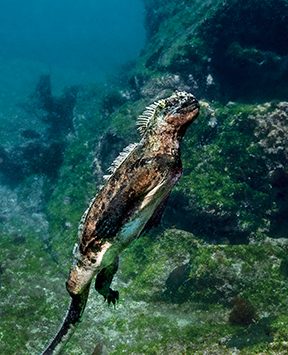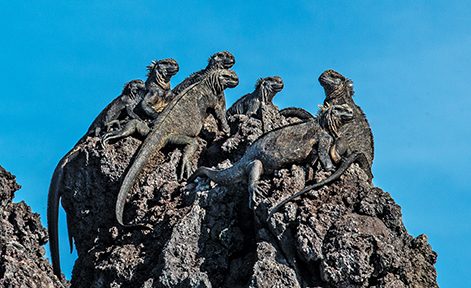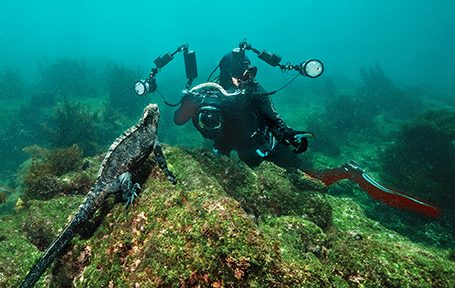INI ADALAH HARI KELIMA PELAYARAN, and our liveaboard has finally finished the overnight crossing south from the warm waters of Darwin and Wolf islands to Cape Douglas, Isla Fernandina. Although we don’t travel a great distance on the journey, we cross the equator and move from summer to winter, where prevailing ocean currents plunge the water temperature 18°F cooler at our destination. Fernandina seems like half an ocean away in terms of the temperature change, a common conundrum when traveling between islands in the Galápagos archipelago.
At Fernandina, our first dive of the morning in 65 feet of water is an opening act for the main event, which we have scheduled to begin promptly at noon. But for this one, our divers don extra layers of neoprene to ward off the chill; we expect the water temperature at the bottom to be 64°F, a considerable change from the balmy 82°F we experienced at Wolf and Darwin. This thermal difference exemplifies the influence that several currents exert on the Galápagos. This confluence is a significant reason for many of its unique attributes, including the iconic creature of our pending date.
Ada alasan mengapa acara utama kami tidak akan terjadi sampai siang hari. Subjek fotografi berdarah dingin kami membutuhkan periode pemanasan di bawah sinar matahari untuk memungkinkan pemberian makan selama beberapa saat di tengah ombak yang dingin.
Like our highly anticipated subjects, I choose to sit out the morning dive, preferring to expend my core warmth on the main event. My dive buddy, Richard Condlyffe, agrees, so we sit on the boat’s top deck, nursing warm cups of tea in the cool air as the rest of the team loads into the rigid inflatable boat (RIB) in full kit for the morning dive.
The weather is nearly perfect. There is only a small ocean swell, but the sea is smooth at our mooring about half a mile offshore. A clear sky adds to our good fortune. The lack of clouds will ensure that our photo subjects receive plenty of warm sunlight, enabling maximum feeding time in the water. Here at Fernandina, we are at the right place at the right time to photograph and video the iconic Galápagos marine iguanas during their feeding period.
Richard dan saya menghabiskan teh kami dan bergerak ke bawah dek untuk menyiapkan peralatan kami saat anggota kapal lainnya menyelesaikan penyelaman pagi.

There are 11 subspecies of Galápagos marine iguanas, and they typically range between 1 foot and 5 feet long.
SEJARAH PANJANG
Before Charles Darwin’s historic visit in 1835, the Galápagos Islands were known to sailors as a place to resupply food and water, but his influential Tentang Asal Usul Spesies sparked international curiosity regarding the archipelago’s unique flora and fauna. The odd marine iguana was one of many species Darwin highlighted in his writings.
Pada tahun 1825, ahli zoologi Thomas Bell pertama kali mengklasifikasikan Amblyrhynchus cristatus, the Galápagos marine iguana. These unique reptiles forage on intertidal and subtidal algae in the relatively cool waters around the islands, which are usually between the mid-60s˚F and 80s°F. As cold-blooded reptiles with a preferred body temperature between 95°F and 99°F, they have evolved a thermoregulation behavior that allows them to graze on the species of red and green algae found in a cold sea, which adds to their uniqueness in the animal kingdom.
Scientists believe that the ancestor to the marine iguana found its way to the Galápagos by hitching a ride on rafts of vegetation from mainland South America, likely millions of years ago. These rafts and their hitchhikers eventually drifted on currents to the remote, uninhabited islands. With few predators and abundant food, the iguana had the time and resources to adapt — and it did precisely that.

Bebatuan vulkanik hitam di pulau-pulau ini merupakan tempat yang sempurna bagi iguana laut untuk berjemur dan menghangatkan diri.

Richard Condlyffe memotret seekor iguana yang sedang patuh.
Early visitors to the Galápagos Islands apparently considered the marine iguana ugly and disgusting. In 1798 Capt. James Colnett of the British Royal Navy described them in his journals as “small, and of a sooty black, which, if possible, heightens their native ugliness. Indeed, so disgusting is their appearance, that no one on board could be prevailed upon to take them as food.”
Mereka pada awalnya menolak Darwin. Pada tanggal 17 September 1835, masuknya Charles Darwin’s Beagle Diary, he wrote, “The black Lava rocks on the beach are frequented by large (2–3 ft) most disgusting, clumsy Lizards. They are as black as the porous rocks over which they crawl & seek their prey from the Sea. – Somebody calls them ‘imps of darkness.’ – They assuredly well become the land they inhabit.” It’s perhaps fortunate that the early visitors to the Galápagos found the reptile unpleasant, and these docile creatures with such environmentally specific needs were left alone to flourish.
Scientists have now classified 11 subspecies, each unique to the islands they inhabit. Marine iguanas usually range from 1 foot to 5 feet in length. Typically, the larger the island, the larger the subspecies, with the iguanas on Isabela and Fernandina being the largest. Whether you think of them as one of nature’s unique sculptures or as miniature Godzillas, these fantastic animals top the list for shooters venturing to the Galápagos Islands. Indeed, beauty is in the eye of the beholder.
PENAMPAKAN YANG DITERANGI MATAHARI
Finally, it’s time for the main event. Richard and I made a good choice when we wagered that sitting out the morning dive would maximize our comfort for the afternoon; several divers still feel chilled.
Kami berangkat dengan RIB pada siang hari dan bermotor tak jauh dari pantai berbatu. Pantai di sini merupakan campuran pasir putih yang diperlukan untuk bertelur selama musim bertelur dan batu vulkanik hitam yang membantu iguana menghangatkan diri dengan cepat. Kondisinya nyaris sempurna, sehingga divemaster kami telah memberi setiap pasangan penyelam bagian selancar yang luas di luar ombak kecil. Richard dan saya memiliki sebuah bingkisan di teluk alami yang berundak-undak dengan cepat dari ketinggian 3 kaki hingga 16 kaki.
The sun has been hot, and as if on cue with our arrival, there are suddenly dozens of black shapes bobbing on the surface all around the RIB. The iguanas are already in the surf! We make a final gear check before rolling back into the 64°F water. With no breeze, it’s hot above the surface, and like our dark-skinned lizard friends, we welcome the cool water.
The shallow cove is beautiful, with red, green, and brown algae shimmering in the bright sunlight. I immediately find a 3-foot iguana munching algae off a rock as I settle to the bottom at 10 feet. With a quick check all around me, I see two more large reptiles within the 26 feet of visibility and realize it won’t be hard to find subjects.
Saya berbalik untuk menunjukkan kadal kepada Richard, tetapi dia sudah memotret subjeknya sendiri. Ada kadal di mana-mana: di dasar, di permukaan, dan beberapa di antaranya perlahan-lahan mengular ke atas.
While easy to approach and ambivalent about presence, they are somewhat tricky subjects to shoot in bright conditions. Getting detail in my images in the high-contrast environment takes some work. Strobes help, but the abundant plankton and particulate matter in the water column result in extensive backscatter. I constantly adjust my strobe angles and power settings, checking my histograms and images in the camera’s viewfinder, looking for the perfect shot.
Dengan hanya satu jam yang berharga untuk mengunjungi hewan-hewan yang luar biasa ini, saya menjelajahi teluk beberapa kali, merekam video dan gambar diam dengan dan tanpa Richard sebagai subjek sekunder. Dan kemudian, secepat itu dimulai, tiba saatnya untuk kembali ke kapal dan meninggalkan subjek kami kepada ikan damselfish dan singa laut yang berbagi wilayah mereka.
In a world of dive experiences spanning many decades, it can be increasingly difficult to find somewhere that inspires childlike wonder. Fortunately, the Galápagos is one of those places. The captivating landscape and extraordinary animals make it easy to imagine you are experiencing it much as Darwin did or perhaps as if you are the first human visitor.
My trip to the Galápagos was astonishing, but the dive with the marine iguanas was beyond so. It was a magical experience that gave me the elusive excitement of discovery, if only for an hour. AD
© Alert Diver — Q2 2022